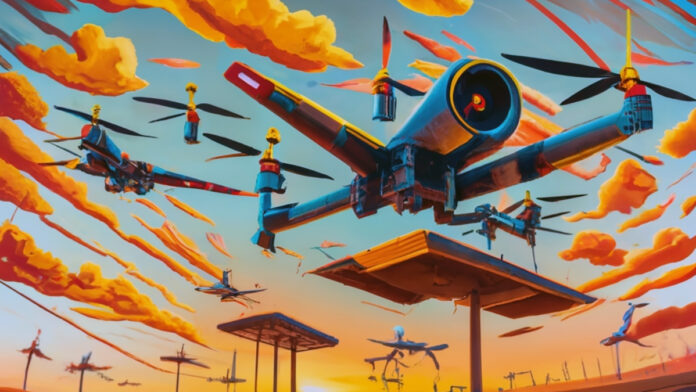
There’s a good deal of innovation behind the scenes of the harsh Russo-Ukrainian war. It’s common knowledge that Russia leverages hybrid warfare tactics that combine cyberattacks, disinformation campaigns, and conventional battles on the ground. In pursuit of asymmetric responses, Ukraine has developed a series of highly effective kamikaze drones. These tools of modern war turn out to be game-changers as they offer a mix of technology and tactics that redefine battlefield dynamics. Let’s go over the ins and outs of this shift and try to shed light on unique unmanned aerial vehicles (UAVs) in the country’s arsenal.
How do kamikaze drones work?
Unlike conventional UAVs, these drones are designed for a single-use mission. They locate, hover, and then dive into their targets, detonating on impact. To ensure precision and high success rates in their missions, such drones are equipped with cutting-edge technology, including GPS guidance, real-time data transmission, and advanced targeting systems.
The utilization of these drones brings multiple strategic benefits. Primarily, they offer a more secure option for military personnel, significantly reducing the likelihood of casualties. Additionally, their capability to operate stealthily at lower altitudes positions them as perfect instruments for unexpected assaults and the neutralization of critical targets. Moreover, their affordability enables their use in substantial quantities, effectively overpowering the defenses of the adversary.
In-depth look at Ukraine’s kamikaze drone arsenal
Ukraine’s diverse array of kamikaze drones each serves a unique purpose on the battlefield, combining advanced technology with strategic design. Here’s a closer look at the technical characteristics and capabilities of each model:
UJ-26 “Bober”
The Bober (meaning “Beaver”) is a long-range barrage munition developed by UkrJet, marking a significant advancement in Ukraine’s UAV capabilities. This drone is an equivalent to the Iranian Shahed 131, widely used by Russians during the invasion of Ukraine. It’s built on an aerodynamic ‘duck’ scheme, enhancing its ability to change altitude and maneuver in the air, thereby increasing its survival chances in hostile environments.
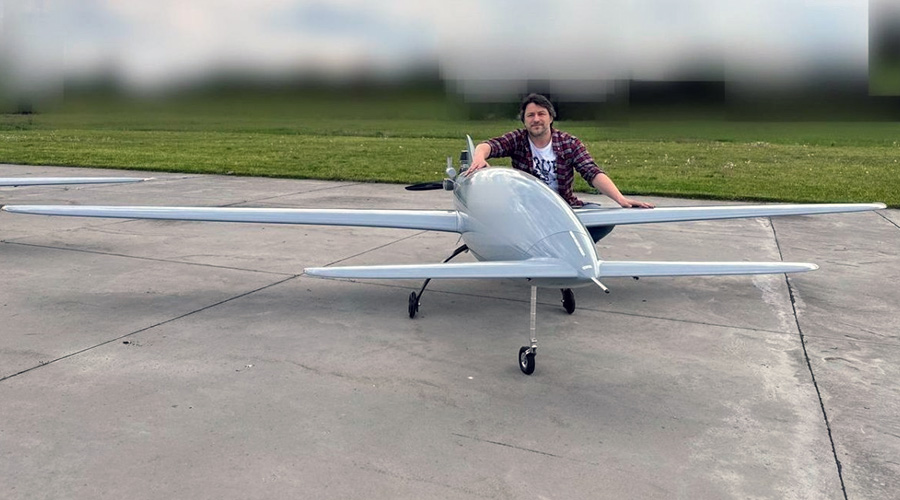
Technical characteristics:
| Length: | 2.5 meters, providing a compact frame for stealth and agility. |
| Wingspan: | Also 2.5 meters, balancing aerodynamics with a broad enough span to support its operational range. |
| Flight range: | Up to 800 kilometers, allowing deep penetration into enemy territory for strategic strikes. |
| Maximum flight duration: | 7 hours, ensuring sustained presence and the ability to wait for the optimal moment to strike. |
| Speed: | 200 km/h, fast enough to evade some slower-moving air defense systems. |
| Weight: | Approximately 150 kg, making it relatively lightweight and easier to deploy. |
| Payload: | Can carry a 20 kg combat part, specifically the KZ-6, which is substantial for targeted attacks on critical infrastructure or equipment. |
The Bober was introduced in 2023, after a public fundraising campaign was announced by the Telegram account @lachentyt in December 2022. This campaign aimed to support the development of a domestic unmanned aerial vehicle for Ukraine’s Main Directorate of Intelligence (HUR). In 2023, these UAVs were used for strikes in Moscow and the Moscow region, and an attack on an airfield in Pskov, 700 kilometers from the Ukrainian border, suggests the use of the Bober due to its long-range capabilities.
The Bober represents a blend of tactical ingenuity and strategic foresight, embodying Ukraine’s resolve to defend its sovereignty and territorial integrity with advanced technology. As the conflict evolves, the Bober’s role on the battlefield is likely to expand, adapting to new challenges and operational requirements.
AQ-400 Scythe
The AQ-400 Scythe is a formidable loitering munition developed by Terminal Autonomy (formerly One Way Aerospace) during the intense period of the 2022 Russian invasion of Ukraine. This drone is not just a piece of machinery; it’s a strategic asset designed to deliver devastating blows to the enemy while being cost-effective and easy to produce.
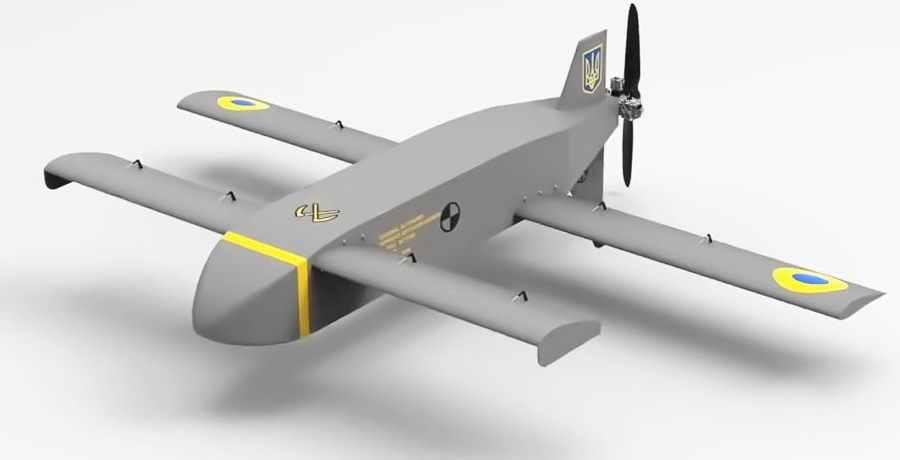
Technical characteristics:
| Weight: | 100 kg, making it a relatively lightweight yet potent weapon. |
| Wingspan: | 2.3 m, providing the necessary lift and stability for its operational tasks. |
| Flight range: | 750 km, allowing deep strikes into enemy territory. |
| Flight altitude: | 30–3,000 m, offering flexibility to operate at various altitudes to evade detection and defenses. |
| Maximum speed: | 200 km/h, fast enough to reach targets quickly and reduce exposure to enemy defenses. |
| Warhead: | 43 kg with a blast yield of 32 kg, capable of carrying thermobaric explosives or two 122 mm artillery shells, ensuring significant destructive power. |
The AQ-400 Scythe is characterized by its swift assembly and mass production capabilities. Its fuselage is made from milled sheets of plywood from civilian furniture factories, a scalable alternative to 3-D printing or fiberglass. This innovative approach allows for the drones to be manufactured at scale without the need for skilled labor. Despite some components being sourced from abroad, the focus is on maximizing production within Ukraine’s borders.
The Scythe has two sets of wings, one forward and one rear, and can take off from short airstrips using its tricycle landing gear or from a catapult using rocket boosters. Its overall weight is 100 kg with a 43 kg payload, which includes a 32 kg warhead. The standard gas engine and pusher propeller provide a cruise speed of 144 km/h, a top speed of 200 km/h, endurance of 6.5 hours, and a strike range of 750 km. Depending on the engine option, the range could be increased to as far as 900 km, or the payload increased to 70 kg at a reduced range.
The AQ-400 employs a low-altitude guidance system using a laser altimeter to approach at 30 m, minimizing the effects of electronic warfare to jam GPS navigation until very close to the target. At higher altitudes of 3,000 m, it navigates with a visual positioning system using roads and other visible landmarks. An optional video link allows an operator to manually guide the drone to hit moving targets, but this adds costs and only works at shorter ranges.
RAM II UAV
The RAM II Unmanned Aerial Vehicle (UAV) is a high-precision combat loitering unmanned aerial system designed to execute precise and effective strikes on enemy forces while minimizing collateral damage, especially in urban areas. This advanced drone is a testament to modern military technology, combining stealth, precision, and power in a compact aerial platform.
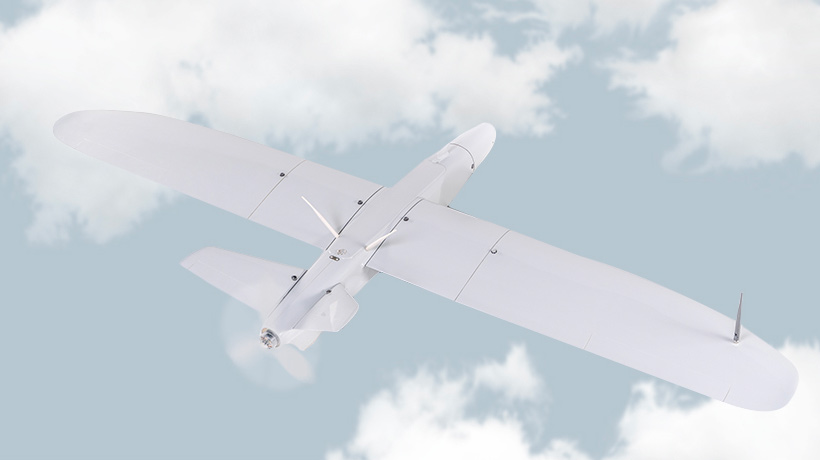
Technical characteristics:
| Dimensions: | The RAM II has a length of 1.45 m, a wingspan of 2584 mm, and a height of 349 mm. With a maximum takeoff weight of 9.8 kg, it’s relatively lightweight for its capabilities. |
| Performance: | It boasts a maximum flight time of 55 minutes, an operating range of 60 km, and a radio range of 30 km. With a cruising speed of 70 km/h and a maximum flight altitude of 1000 m, it’s swift and capable of reaching high altitudes. |
| Warhead: | The fully loaded combat UAV can carry a 3 kg warhead and operate within a range of 30 km from the launch point, making it deadly and versatile. It can complete both surveillance and combat missions effectively. |
| Warhead types: | Thermobaric, High-Explosive Anti-Tank (HEAT), High-Explosive Fragmentation |
| Engine type: | Electric |
| Operating conditions: | Designed to operate in temperatures ranging from -20°С to +40°С, the RAM II is versatile and robust enough to face various environmental conditions. |
As conflicts evolve and demand more advanced solutions, the RAM II stands ready to deliver decisive results on the battlefield.
UJ-25 Skyline
The UJ-25 Skyline is a cutting-edge kamikaze drone developed by the Ukrainian enterprise UkrJet. This reactive drone-kamikaze represents a significant leap in unmanned aerial technology, designed to deliver precise and devastating strikes against enemy targets. The UJ-25 Skyline is similar in design to a winged missile with reverse sweep wings and a V-shaped tail. It’s equipped with an air-jet engine that ensures remarkable speed and maneuverability. The drone’s exact specifications are not definitively known, but it’s presumed that they might be similar to those of the UJ-23 Topaz, as claimed by the manufacturer.
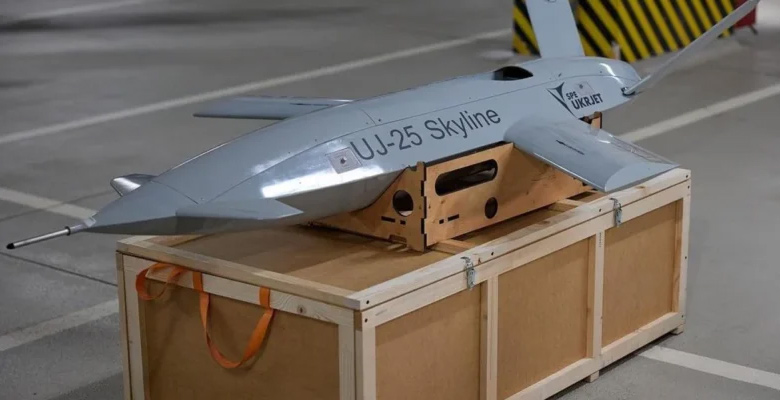
The speculated characteristics include:
| Cruising speed: | 600 km/h, allowing for rapid transit to the target area. |
| Maximum speed: | 800 km/h, enabling quick strikes and the ability to evade enemy defenses. |
| Time in air: | 90 minutes, providing ample time for complex missions. |
| Maximum range: | 800 km, allowing for deep penetration into enemy territory. |
| Warhead: | 10 kg, substantial enough to cause significant damage to targets. |
The UJ-25 Skyline first made a public appearance in September 2023 during a CNN interview with Ukraine’s Minister of Digital Transformation, Mykhailo Fedorov. In late December 2023, we saw first reported combat use of the drone as its remnants were found in the Russian-occupied Berdyansk. This incident marked the UJ-25 Skyline’s entry into the battlefield and demonstrated its operational capability.
With its high-speed capabilities and potential stealth features, the UJ-25 Skyline is designed to deliver precise strikes, disrupt enemy operations, and provide a strategic advantage in the complex theater of war. As the conflict evolves, the UJ-25 Skyline is expected to play a pivotal role in shaping the aerial strategies and tactics of Ukraine.
The transformative role of Ukraine’s kamikaze drones
Ukraine’s deployment of kamikaze drones has dramatically changed the dynamics of warfare in the region, showcasing a shift towards more asymmetric and technology-driven combat methods. Let’s go over 7 ways this tech has given the landscape of the conflict a strategic overhaul.
- Disruption of enemy supply lines:
The ability of these drones to penetrate deep into enemy territory and target supply convoys has significantly hindered the adversary’s logistical operations. By cutting off supplies and ammunition, these drones have effectively weakened the enemy’s ability to sustain prolonged engagements, leading to a strategic advantage for Ukrainian forces. - Destruction of critical infrastructure:
Kamikaze drones have been employed to target and destroy critical enemy infrastructure, such as command centers, communication nodes, and weapon depots. This has not only caused direct damage but also sown chaos and confusion within enemy ranks, disrupting their ability to coordinate and respond effectively. - Provision of valuable intelligence:
Equipped with cameras and sensors, these drones have gathered crucial intelligence on enemy movements, fortifications, and tactics. This information has been invaluable for planning counteroffensives, adjusting defensive strategies, and predicting enemy actions, thereby enhancing the overall situational awareness of Ukrainian forces. - Bolstering defensive capabilities:
The use of kamikaze drones has significantly bolstered Ukraine’s defensive capabilities. By providing a cost-effective and risk-free means of engaging the enemy, these drones have allowed Ukrainian forces to conduct offensive operations while minimizing their own casualties and preserving their fighting strength. - Sending a global message:
The success of Ukraine’s kamikaze drones has sent a clear message to the world about the changing face of warfare. It has highlighted the growing importance of unmanned systems and asymmetric tactics in modern conflicts, prompting militaries worldwide to rethink their strategies and invest in similar technologies. - Psychological impact:
Beyond their physical destruction, these drones have had a profound psychological impact on enemy forces. The constant threat of an unseen and unpredictable aerial attack has eroded morale and created a sense of vulnerability, further diminishing the enemy’s will to fight. - Setting a precedent for future conflicts:
Ukraine’s effective use of kamikaze drones is setting a precedent for future conflicts. It demonstrates how smaller, technologically savvy forces can challenge larger, more traditional militaries, potentially reshaping the nature of global warfare in the 21st century.
To recap, Ukraine’s kamikaze drones are more than just a military asset. They signal a shift towards all all-new age of warfare where technology comes first. As these UAVs continue to evolve and improve, they will undoubtedly shape the strategies and outcomes of future conflicts. The world is witnessing Ukraine not only defending its present but also paving the way for the future of military tactics and strategies.




























